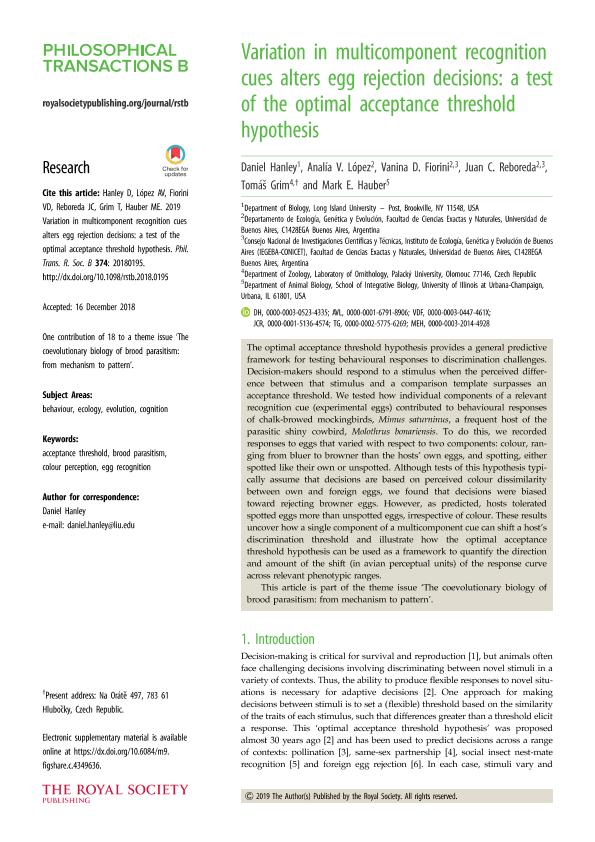Mostrar el registro sencillo del ítem
dc.contributor.author
Hanley, Daniel
dc.contributor.author
López Díaz, Analía Valeria

dc.contributor.author
Fiorini, Vanina Dafne

dc.contributor.author
Reboreda, Juan Carlos

dc.contributor.author
Grim, Tomá
dc.contributor.author
Hauber, Mark E.
dc.date.available
2022-08-01T11:02:15Z
dc.date.issued
2019-04
dc.identifier.citation
Hanley, Daniel; López Díaz, Analía Valeria; Fiorini, Vanina Dafne; Reboreda, Juan Carlos; Grim, Tomá; et al.; Variation in multicomponent recognition cues alters egg rejection decisions: A test of the optimal acceptance threshold hypothesis; The Royal Society; Philosophical Transactions of the Royal Society B: Biological Sciences; 374; 1769; 4-2019; 1-10
dc.identifier.issn
0962-8436
dc.identifier.uri
http://hdl.handle.net/11336/163609
dc.description.abstract
The optimal acceptance threshold hypothesis provides a general predictive framework for testing behavioural responses to discrimination challenges. Decision-makers should respond to a stimulus when the perceived difference between that stimulus and a comparison template surpasses an acceptance threshold. We tested how individual components of a relevant recognition cue (experimental eggs) contributed to behavioural responses of chalk-browed mockingbirds, Mimus saturninus, a frequent host of the parasitic shiny cowbird, Molothrus bonariensis. To do this, we recorded responses to eggs that varied with respect to two components: colour, ranging from bluer to browner than the hosts’ own eggs, and spotting, either spotted like their own or unspotted. Although tests of this hypothesis typically assume that decisions are based on perceived colour dissimilarity between own and foreign eggs, we found that decisions were biased toward rejecting browner eggs. However, as predicted, hosts tolerated spotted eggs more than unspotted eggs, irrespective of colour. These results uncover how a single component of a multicomponent cue can shift a host’s discrimination threshold and illustrate how the optimal acceptance threshold hypothesis can be used as a framework to quantify the direction and amount of the shift (in avian perceptual units) of the response curve across relevant phenotypic ranges. This article is part of the theme issue ‘The coevolutionary biology of brood parasitism: from mechanism to pattern’.
dc.format
application/pdf
dc.language.iso
eng
dc.publisher
The Royal Society

dc.rights
info:eu-repo/semantics/openAccess
dc.rights.uri
https://creativecommons.org/licenses/by-nc-sa/2.5/ar/
dc.subject
ACCEPTANCE THRESHOLD
dc.subject
BROOD PARASITISM
dc.subject
COLOUR PERCEPTION
dc.subject
EGG RECOGNITION
dc.subject.classification
Zoología, Ornitología, Entomología, Etología

dc.subject.classification
Ciencias Biológicas

dc.subject.classification
CIENCIAS NATURALES Y EXACTAS

dc.title
Variation in multicomponent recognition cues alters egg rejection decisions: A test of the optimal acceptance threshold hypothesis
dc.type
info:eu-repo/semantics/article
dc.type
info:ar-repo/semantics/artículo
dc.type
info:eu-repo/semantics/publishedVersion
dc.date.updated
2020-11-20T14:48:49Z
dc.journal.volume
374
dc.journal.number
1769
dc.journal.pagination
1-10
dc.journal.pais
Reino Unido

dc.journal.ciudad
Londres
dc.description.fil
Fil: Hanley, Daniel. Long Island University; Estados Unidos
dc.description.fil
Fil: López Díaz, Analía Valeria. Universidad de Buenos Aires. Facultad de Ciencias Exactas y Naturales. Departamento de Ecología, Genética y Evolución; Argentina. Consejo Nacional de Investigaciones Científicas y Técnicas; Argentina
dc.description.fil
Fil: Fiorini, Vanina Dafne. Consejo Nacional de Investigaciones Científicas y Técnicas. Oficina de Coordinación Administrativa Ciudad Universitaria. Instituto de Ecología, Genética y Evolución de Buenos Aires. Universidad de Buenos Aires. Facultad de Ciencias Exactas y Naturales. Instituto de Ecología, Genética y Evolución de Buenos Aires; Argentina
dc.description.fil
Fil: Reboreda, Juan Carlos. Consejo Nacional de Investigaciones Científicas y Técnicas. Oficina de Coordinación Administrativa Ciudad Universitaria. Instituto de Ecología, Genética y Evolución de Buenos Aires. Universidad de Buenos Aires. Facultad de Ciencias Exactas y Naturales. Instituto de Ecología, Genética y Evolución de Buenos Aires; Argentina
dc.description.fil
Fil: Grim, Tomá. Palacky´ University; República Checa
dc.description.fil
Fil: Hauber, Mark E.. University of Illinois. Urbana - Champaign; Estados Unidos
dc.journal.title
Philosophical Transactions of the Royal Society B: Biological Sciences

dc.relation.alternativeid
info:eu-repo/semantics/altIdentifier/url/https://royalsocietypublishing.org/doi/full/10.1098/rstb.2018.0195
dc.relation.alternativeid
info:eu-repo/semantics/altIdentifier/doi/http://dx.doi.org/10.1098/rstb.2018.0195
Archivos asociados
